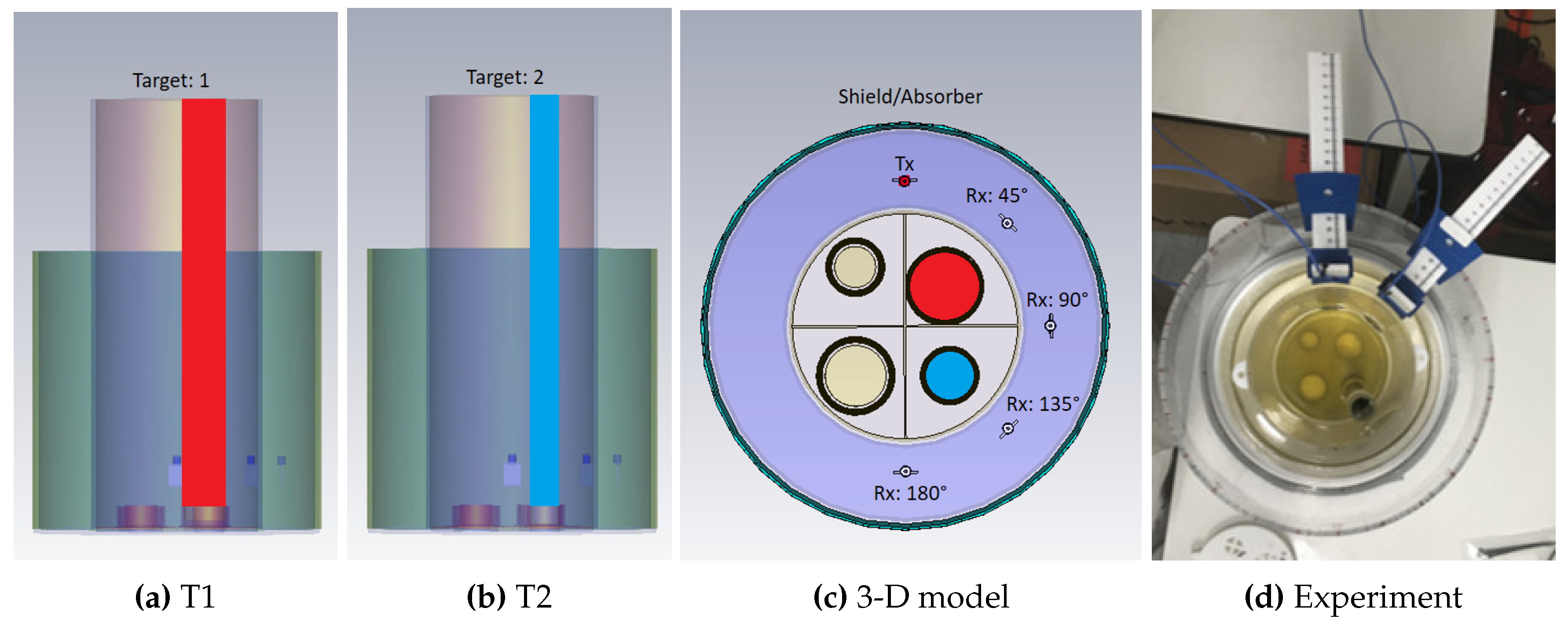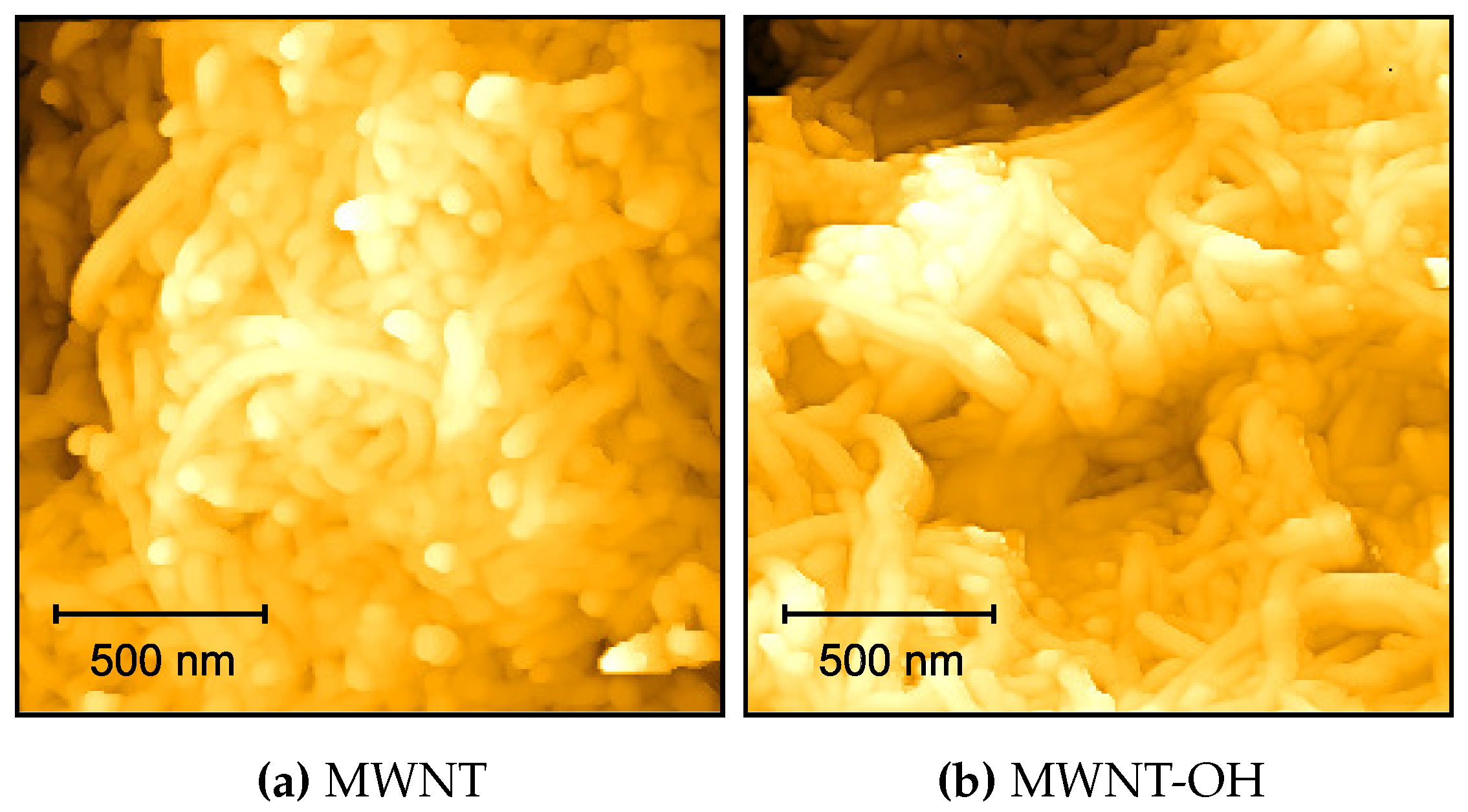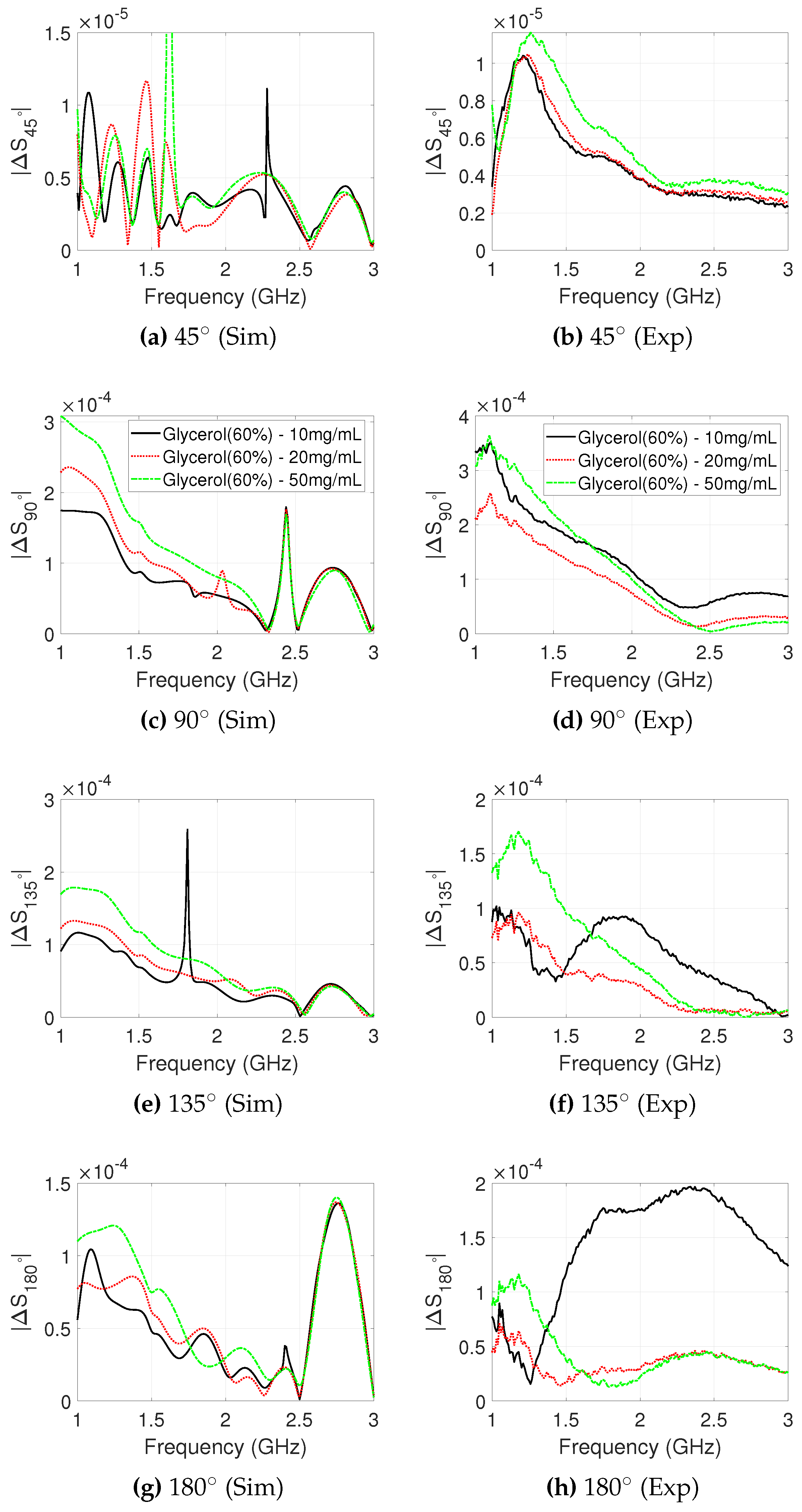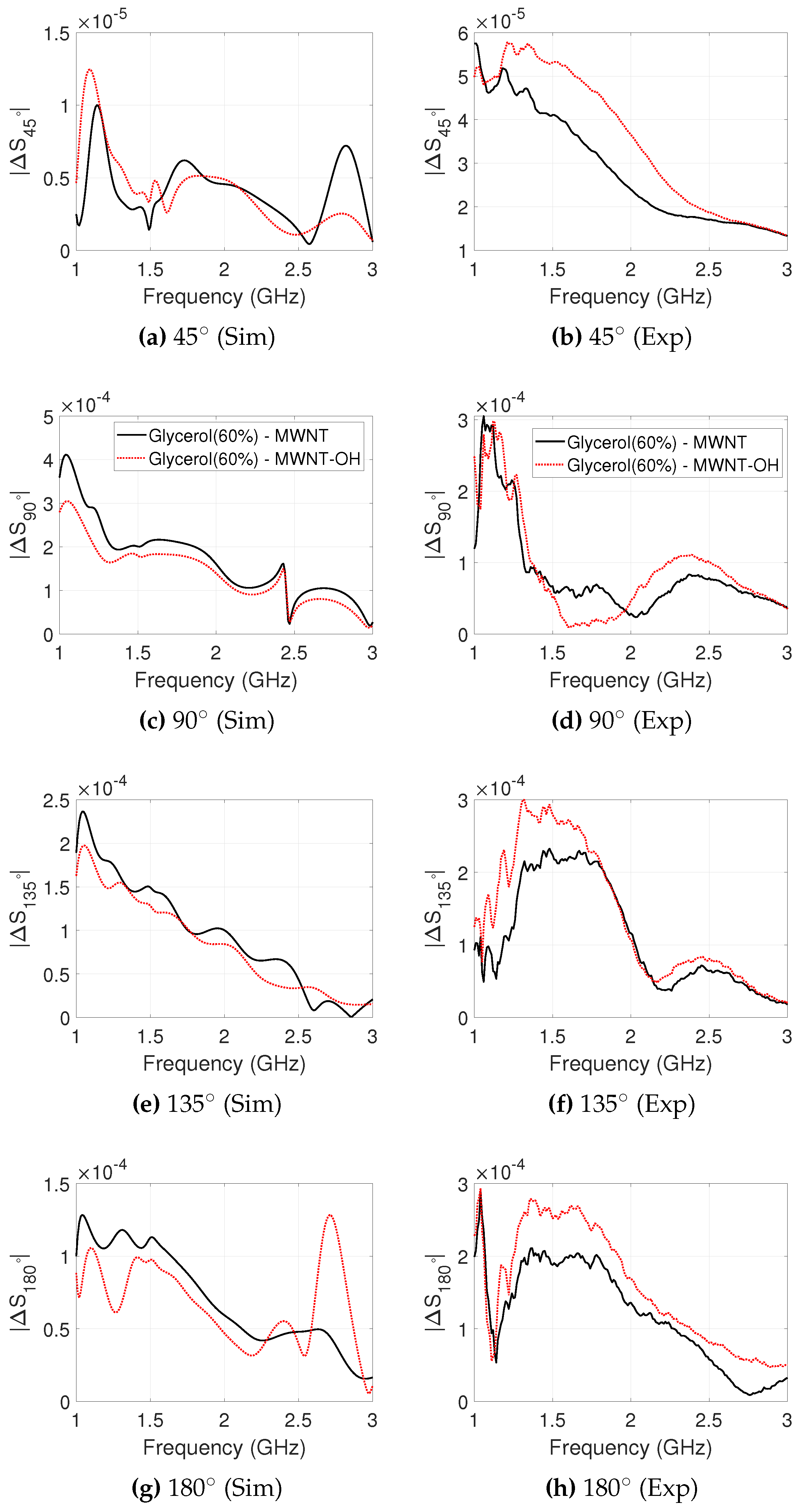Assessing Changes in Dielectric Properties Due to Nanomaterials Using a Two-Port Microwave System
Abstract
1. Introduction
2. Materials and Methods
2.1. Atomic Force Microscopy (AFM)
2.2. Dielectric Characterisation
2.3. Microwave Experimental Method
3. Results
3.1. Size Characterisation for MWNT and MWNT-OH NPs
3.2. Dielectric Spectroscopy Measurements
3.3. Microwave System Measurements
3.3.1. Salt (NaCl)
3.3.2. MWNT and MWNT-OH Suspensions
4. Discussion
4.1. Dielectric Spectroscopy Analysis
4.2. Microwave System Analysis
4.3. Contributions
Author Contributions
Funding
Conflicts of Interest
References
- Asefi, M.; Jeffrey, I.; LoVetri, J.; Gilmore, C.; Card, P.; Paliwal, J. Grain bin monitoring via electromagnetic imaging. Comput. Electron. Agric. 2015, 119, 133–141. [Google Scholar] [CrossRef]
- Wu, Z.; McCann, H.; Davis, L.E.; Hu, J.; Fontes, A.; Xie, C.G. Microwave-tomographic system for oil- and gas-multiphase-flow imaging. Meas. Sci. Technol. 2009, 20, 1–8. [Google Scholar] [CrossRef]
- Meaney, P.M.; Fanning, M.W.; Li, D.; Poplack, S.P.; Paulsen, K.D. A clinical prototype for active microwave imaging of the breast. IEEE Trans. Microw. Theory Tech. 2000, 48, 1841–1853. [Google Scholar]
- Preece, A.W.; Craddock, I.; Shere, M.; Jones, L.; Winton, H.L. MARIA M4: Clinical evaluation of a prototype ultrawideband radar scanner for breast cancer detection. J. Biomed. Imaging 2016, 3, 1–7. [Google Scholar] [CrossRef] [PubMed]
- Lazebnik, M.; McCartney, L.; Popovic, D.; Watkins, C.B.; Lindstrom, M.J.; Harter, J.; Sewall, S.; Magliocco, A.; Booske, J.H.; Okoniewski, M.; et al. A large-scale study of the ultrawideband microwave dielectric properties of normal breast tissue obtained from reduction surgeries. Phys. Med. Biol. 2007, 52, 2637. [Google Scholar] [CrossRef] [PubMed]
- Lazebnik, M.; Popovic, D.; McCartney, L.; Watkins, C.B.; Lindstrom, M.J.; Harter, J.; Sewall, S.; Ogilvie, T.; Magliocco, A.; Breslin, T.M.; et al. A large-scale study of the ultrawideband microwave dielectric properties of normal, benign and malignant breast tissues obtained from cancer surgeries. Phys. Med. Biol. 2007, 52, 6093. [Google Scholar] [CrossRef] [PubMed]
- Cheng, Y.; Fu, M. Dielectric properties for non-invasive detection of normal, benign, and malignant breast tissues using microwave theories. Thoracic Cancer 2018, 9, 459–465. [Google Scholar] [CrossRef]
- Joines, W.T.; Zhang, Y.; Li, C.; Jirtle, R.L. The measured electrical properties of normal and malignant human tissues from 50 to 900 MHz. Med. Phys. 1994, 21, 547–550. [Google Scholar] [CrossRef]
- Surowiec, A.J.; Stuchly, S.S.; Barr, J.R.; Swarup, A. Dielectric properties of breast carcinoma and the surrounding tissues. IEEE Trans. Biomed. Eng. 1988, 35, 257–263. [Google Scholar] [CrossRef]
- Popovic, D.; Hagl, D.; Beasley, C.; Okoniewski, M.; Hagness, S.C.; Booske, J.H. Sensing volume of open-ended coaxial probes for dielectric characterization of breast tissue at microwave frequencies. IEEE Trans. Microwave Theory Tech. 2003, 51, 1194–1206. [Google Scholar]
- Meaney, P.M.; Gregory, A.P.; Epstein, N.R.; Paulsen, K.D. Microwave open-ended coaxial dielectric probe: Interpretation of the sensing volume re-visited. BMC Med. Phys. 2014, 14, 3. [Google Scholar] [CrossRef] [PubMed]
- Sabouni, A.; Hahn, C.; Noghanian, S.; Sauter, E.; Weiland, T. Study of the Effects of Changing Physiological Conditions on Dielectric Properties of Breast Tissues. ISRN Biomed. Imaging 2013, 2013, 1–5. [Google Scholar] [CrossRef]
- La Gioia, A.; Porter, E.; Merunka, I.; Shahzad, A.; Salahuddin, S.; Jones, M.; O’Halloran, M. Open-Ended Coaxial Probe Technique for Dielectric Measurement of Biological Tissues: Challenges and Common Practices. Diagnostics 2018, 8, 40. [Google Scholar] [CrossRef] [PubMed]
- Pollacco, D.A.; Farina, L.; Wismayer, P.S.; Farrugia, L.; Sammut, C.V. Characterization of the dielectric properties of biological tissues and their correlation to tissue hydration. IEEE Trans. Dielectr. Electr. Insul. 2018, 25, 2191–2197. [Google Scholar] [CrossRef]
- Shahzad, A.; Khan, S.; Jones, M.; Dwyer, R.M.; O’Halloran, M. Investigation of the effect of dehydration on tissue dielectric properties in ex vivo measurements. Biomed. Phys. Eng. Express 2017, 3, 045001. [Google Scholar] [CrossRef]
- Jithin, D.; Hussein, M.I.; Awwad, F.; Irtini, R. Dielectric characterization of breast cancer cell lines using microwaves. In Proceedings of the 2016 5th International Conference on Electronic Devices, Systems and Applications (ICEDSA), Ras Al Khaimah, UAE, 6–8 December 2016. [Google Scholar]
- Ahmad, M.A.; Natour, Z.A.; Mustafa, F.; Rizvi, T.A. Electrical Characterization of Normal and Cancer Cells. IEEE Access 2018, 6, 25979–25986. [Google Scholar] [CrossRef]
- Caschera, L.; Lazzara, A.; Piergallini, L.; Ricci, D.; Tuscano, B.; Vanzulli, A. Contrast agents in diagnostic imaging: Present and future. Pharmacol. Res. 2016, 110, 65–75. [Google Scholar] [CrossRef]
- Shea, J.D.; Kosmas, P.; Hagness, S.C.; Veen, B.D.V. Contrast-enhanced microwave breast imaging. In Proceedings of the 2009 13th International Symposium on Antenna Technology and Applied Electromagnetics and the Canadian Radio Science Meeting, Toronto, ON, Canada, 15–18 February 2009. [Google Scholar]
- Chen, Y.; Kosmas, P.; Martel, S. A feasibility study for microwave breast cancer detection using contrast-agent-loaded bacterial microbots. Int. J. Antennas Propag. 2013, 2013, 11. [Google Scholar] [CrossRef]
- Colzani, B.; Pandolfi, L.; Hoti, A.; Iovene, P.A.; Natalello, A.; Avvakumova, S.; Colombo, M.; Prosperi, D. Investigation of antitumor activities of trastuzumab delivered by PLGA nanoparticles. Int. J. Nanomed. 2018, 13, 957–973. [Google Scholar] [CrossRef]
- Dziawer, L.; Majkowska-Pilip, A.; Gawel, D.; Godlewska, M.; Pruszynski, M.; Jastrzębski, J.; Wąs, B.; Bilewicz, A. Trastuzumab-Modified Gold Nanoparticles Labeled with 211At as a Prospective Tool for Local Treatment of HER2-Positive Breast Cancer. Nanomaterials 2019, 9, 632. [Google Scholar] [CrossRef]
- Ogunlade, O.; Beard, P. Exogenous contrast agents for thermoacoustic imaging: An investigation into the underlying sources of contrast. Med. Phys. 2015, 42, 170–181. [Google Scholar] [CrossRef] [PubMed]
- Bucci, O.M.; Bellizzi, G.; Bellizzi, G.G. Microwave Broadband Characterization of a Diluted Water-Based Ferrofluid in Presence of a Polarizing Magnetic Field. IEEE Trans. Magn. 2017, 53, 1–8. [Google Scholar] [CrossRef]
- Bucci, O.M.; Bellizzi, G.; Borgia, A.; Costanzo, S.; Crocco, L.; Massa, G.D.; Scapaticci, R. Experimental feasibility assessment of MNP enhanced microwave diagnostics of breast cancer. In Proceedings of the 2016 10th European Conference on Antennas and Propagation (EuCAP), Davos, Switzerland, 10–15 April 2016. [Google Scholar]
- Bucci, O.M.; Bellizzi, G.; Borgia, A.; Costanzo, S.; Crocco, L.; Massa, G.D.; Scapaticci, R. Characterization of a laboratory set-up for assessing the feasibility of magnetic nanoparticles enhanced microwave imaging. In Proceedings of the 2016 10th European Conference on Antennas and Propagation (EuCAP), Davos, Switzerland, 10–15 April 2016. [Google Scholar]
- Green, M.; Chen, X. Recent progress of nanomaterials for microwave absorption. J. Materiomics 2019, 5, 503–541. [Google Scholar] [CrossRef]
- Liu, X.; Chen, H.j.; Chen, X.; Parini, C.; Wen, D. Low frequency heating of gold nanoparticle dispersions for non-invasive thermal therapies. Nanoscale 2012, 4, 3945–3953. [Google Scholar] [CrossRef]
- Abdelhalim, M.A.K.; Mady, M.M.; Ghannam, M.M. Rheological and dielectric properties of different gold nanoparticle sizes. Lipids Health Dis. 2011, 10, 208. [Google Scholar] [CrossRef]
- Lahri, R.; Rahman, M.; Hernández-Gil, J.; Long, N.; Kosmas, P.; Thanou, M. Examination of zinc ferrites vs. iron oxides as contrast agents for microwave systems. In Proceedings of the 2019 13th European Conference on Antennas and Propagation (EuCAP), Krakow, Poland, 31 March–5 April 2019. [Google Scholar]
- Rahman, M.W.; Lahri, R.; Wright, M.; Koutsoupidou, M.; Kallos, T.; Thanou, M.; Kosmas, P. Characterisation of ZnO NPs as contrast agents for MWI. In Proceedings of the 2017 International Conference on Electromagnetics in Advanced Applications (ICEAA), Verona, Italy, 11–15 September 2017. [Google Scholar]
- Lahri, R.; Rahman, M.; Wright, M.; Kosmas, P.; Thanou, M. Zinc oxide nanoparticles as contrast-enhancing agents for microwave imaging. Med. Phys. 2018, 45, 3820–3830. [Google Scholar] [CrossRef]
- Ding, Y.; Zhang, Z.; Luo, B.; Liao, Q.; Liu, S.; Liu, Y.; Zhang, Y. Investigation on the broadband electromagnetic wave absorption properties and mechanism of Co3O4-nanosheets/reduced-graphene-oxide composite. Nano Res. 2017, 10, 980–990. [Google Scholar] [CrossRef]
- Song, C.; Yin, X.; Han, M.; Li, X.; Hou, Z.; Zhang, L.; Cheng, L. Three-dimensional reduced graphene oxide foam modified with ZnO nanowires for enhanced microwave absorption properties. Carbon 2017, 116, 50–58. [Google Scholar] [CrossRef]
- Mashal, A.; Sitharaman, B.; Li, X.; Avti, P.K.; Sahakian, A.V.; Booske, J.H.; Hagness, S.C. Toward carbon-nanotube-based theranostic agents for microwave detection and treatment of breast cancer: Enhanced dielectric and heating response of tissue-mimicking materials. IEEE Trans. Biomed. Eng. 2010, 57, 1831–1834. [Google Scholar] [CrossRef]
- Lan, S.W.; Weng, M.H.; Yang, R.Y.; Chang, S.J.; Chung, Y.S.; Yu, T.C.; Wu, C.S. Preparation of a Carbon Doped Tissue-Mimicking Material with High Dielectric Properties for Microwave Imaging Application. Materials 2016, 9, 559. [Google Scholar] [CrossRef]
- Xie, S.; Gao, F.; Patel, S.C.; Booske, J.H.; Hagness, S.C.; Sitharaman, B. Effect of synthesis and acid purification methods on the microwave dielectric properties of single-walled carbon nanotube aqueous dispersions. Appl. Phys. Lett. 2013, 103, 133114. [Google Scholar] [CrossRef]
- Xie, S.X.; Gao, F.; Patel, S.C.; Booske, J.H.; Hagness, S.C.; Sitharaman, B. Clinically Relevant CNT Dispersions With Exceptionally High Dielectric Properties for Microwave Theranostic Applications. IEEE Trans. Biomed. Eng. 2014, 61, 2718–2723. [Google Scholar] [CrossRef] [PubMed]
- Ebbesen, T.W.; Lezec, H.J.; Hiura, H.; Bennett, J.W.; Ghaemi, H.F.; Thio, T. Electrical conductivity of individual carbon nanotubes. Nature 1996, 382, 54–56. [Google Scholar] [CrossRef]
- Zaporotskova, I.V.; Boroznina, N.P.; Parkhomenko, Y.N.; Kozhitov, L.V. Carbon nanotubes: Sensor properties. A review. Mod. Electron. Mater. 2016, 2, 95–105. [Google Scholar] [CrossRef]
- Zhao, D.L.; Zhang, J.M.; Li, X.; Shen, Z.M. Electromagnetic and microwave absorbing properties of Co-filled carbon nanotubes. J. Alloys Compd. 2010, 505, 712–716. [Google Scholar] [CrossRef]
- Zhang, L.; Zhu, H. Dielectric, magnetic, and microwave absorbing properties of multi-walled carbon nanotubes filled with Sm2O3 nanoparticles. Mater. Lett. 2009, 63, 272–274. [Google Scholar] [CrossRef]
- Zou, T.; Li, H.; Zhao, N.; Shi, C. Electromagnetic and microwave absorbing properties of multi-walled carbon nanotubes filled with Ni nanowire. J. Alloys Compd. 2010, 496, L22–L24. [Google Scholar] [CrossRef]
- Zhu, H.; Lin, H.; Guo, H.; Yu, L. Microwave absorbing property of Fe-filled carbon nanotubes synthesized by a practical route. Mater. Sci. Eng. B 2007, 138, 101–104. [Google Scholar] [CrossRef]
- Lin, H.; Zhu, H.; Guo, H.; Yu, L. Investigation of the microwave-absorbing properties of Fe-filled carbon nanotubes. Mater. Lett. 2007, 61, 3547–3550. [Google Scholar] [CrossRef]
- Zhao, C.; Zhang, A.; Zheng, Y.; Luan, J. Electromagnetic and microwave-absorbing properties of magnetite decorated multiwalled carbon nanotubes prepared with poly(N-vinyl-2-pyrrolidone). Mater. Res. Bull. 2012, 47, 217–221. [Google Scholar] [CrossRef]
- Eerenstein, W.; Mathur, N.D.; Scott, J.F. Multiferroic and magnetoelectric materials. Nature 2006, 442, 759–765. [Google Scholar] [CrossRef] [PubMed]
- Qiu, J.; Qiu, T. Fabrication and microwave absorption properties of magnetite nanoparticle–carbon nanotube–hollow carbon fiber composites. Carbon 2015, 81, 20–28. [Google Scholar] [CrossRef]
- Nörtemann, K.; Hilland, J.; Kaatze, U. Dielectric Properties of Aqueous NaCl Solutions at Microwave Frequencies. J. Phys. Chem. A 1997, 101, 6864–6869. [Google Scholar] [CrossRef]
- Lasne, Y.; Paillou, P.; Freeman, A.; Farr, T.; McDonald, K.C.; Ruffie, G.; Malezieux, J.; Chapman, B.; Demontoux, F. Effect of Salinity on the Dielectric Properties of Geological Materials: Implication for Soil Moisture Detection by Means of Radar Remote Sensing. IEEE Trans. Geosci. Remote Sens. 2008, 46, 1674–1688. [Google Scholar] [CrossRef]
- Ahsan, S.; Guo, Z.; Miao, Z.; Sotiriou, I.; Koutsoupidou, M.; Kallos, E.; Palikaras, G.; Panagiotis, K. Design and experimental validation of a multiple-frequency microwave tomography system employing the DBIM-TwIST algorithm. Sensors 2018, 18, 3491. [Google Scholar] [CrossRef] [PubMed]
- Li, X.; Sahakian, A.V.; Messersmith, P.; Hagness, S.C.; Booske, J.H.; Knezevic, I. Nanoparticle Contrast Agents for Enhanced Microwave Imaging and Thermal Treatment of Breast Cancer. Available online: https://apps.dtic.mil/dtic/tr/fulltext/u2/a565499.pdf (accessed on 17 July 2020).
- Francis, A.P.; Devasena, T. Toxicity of carbon nanotubes: A review. Toxicol. Ind. Health 2018, 34, 200–210. [Google Scholar] [CrossRef]
- Kobayashi, N.; Izumi, H.; Morimoto, Y. Review of toxicity studies of carbon nanotubes. J. Occup. Health 2017, 59, 394–407. [Google Scholar] [CrossRef]
- Kavosi, A.; Hosseini Ghale Noei, S.; Madani, S.; Khalighfard, S.; Khodayari, S.; Khodayari, H.; Mirzaei, M.; Kalhori, M.R.; Yavarian, M.; Alizadeh, A.M.; et al. The toxicity and therapeutic effects of single-and multi-wall carbon nanotubes on mice breast cancer. Sci. Rep. 2018, 8, 1–12. [Google Scholar] [CrossRef]
- Son, K.H.; Hong, J.H.; Lee, J.W. Carbon nanotubes as cancer therapeutic carriers and mediators. Int. J. Nanomed. 2016, 8, 5163–5185. [Google Scholar] [CrossRef]
- Gupta, A.; Liberati, T.A.; Verhulst, S.J.; Main, B.J.; Roberts, M.H.; Potty, A.G.R.; Pylawka, T.K.; El-Amin III, S.F. Biocompatibility of single-walled carbon nanotube composites for bone regeneration. Bone Jt. Res. 2015, 4, 70–77. [Google Scholar] [CrossRef]
- Gabriel, S.; Lau, R.W.; Gabriel, C. The dielectric properties of biological tissues: III. Parametric models for the dielectric spectrum of tissues. Phys. Med. Biol. 1996, 41, 2271. [Google Scholar] [CrossRef] [PubMed]
- Chaudhry, A.; Baruah, B.; Goyal, A.; Kink, T.; Young, P.; Douglas-Jones, A.; Mansel, R. Differences in Dielectric Properties between Malignant and Normal Breast Tissue: Preliminary Results of the MicroBlate® Study. Cancer Res. 2009, 69, 3099. [Google Scholar]
- Sha, L.; Ward, E.R.; Stroy, B. A review of dielectric properties of normal and malignant breast tissue. In Proceedings of the IEEE SoutheastCon 2002 (Cat. No.02CH37283), Columbia, SC, USA, 5–7 April 2002. [Google Scholar]
- Yoo, D.S. The dielectric properties of cancerous tissues in a nude mouse xenograft model. Bioelectromagnetics 2004, 25, 492–497. [Google Scholar] [CrossRef]
- Bartoli, F.J.; Birch, J.N.; McDuffie, G.E. Conductivity, Dielectric Relaxation, and Viscosity of NaCl–Glycerol Solutions. J. Chem. Phys. 1968, 49, 1916–1921. [Google Scholar] [CrossRef]
- Rahman, M.; Ahsan, S.; Lahri, R.; Thanou, M.; Kosmas, P. Preliminary Assessment of a Microwave System to Detect Contrast Enhancing Agents. In Proceedings of the 2018 40th Annual International Conference of the IEEE Engineering in Medicine and Biology Society (EMBC), Honolulu, HI, USA, 18–21 July 2018. [Google Scholar]
- Puzenko, A.; Hayashi, Y.; Ryabov, Y.; Balin, E.; Feldman, Y.; Kaateze, U.; Behrends, R. Relaxation Dynamics in Glycerol-Water Mixtures: I. Glycerol-Rich Mixture. J. Chem. Phys. B 2005, 109, 6031–6035. [Google Scholar] [CrossRef] [PubMed]
- Sudo, S.; Shinyashiki, N.; Kitsuki, Y.; Yagihara, S. Dielectric Relaxation Time and Relaxation Time Distribution of Alcohol-Water Mixtures. J. Chem. Phys. A 2002, 106, 458–464. [Google Scholar] [CrossRef]
- Sudo, S.; Shimomura, M.; Shinyashiki, N.; Yagihara, S. Broadband dielectric study of α-β seperation for supercooled glycerol-water mixtures. J. Non Cryst. Solids 2002, 307–310, 356–363. [Google Scholar] [CrossRef]
- Poncharal, P.; Berger, C.; Yi, Y.; Wang, Z.L.; de Heer, W.A. Room Temperature Ballistic Conduction in Carbon Nanotubes. J. Chem. Phys. B 2002, 106, 12104–12118. [Google Scholar] [CrossRef]
- Kim, S.S.; Kim, S.T.; Yoon, Y.C.; Lee, K.S. Magnetic, dielectric, and microwave absorbing properties of iron particles dispersed in rubber matrix in gigahertz frequencies. J. Appl. Phys. 2005, 97, 10F905. [Google Scholar] [CrossRef]







| CNT | Stated Width () | AFM Width () |
|---|---|---|
| MWNT | 20 – 30 | ± |
| MWNT-OH | 20 – 30 | ± |
Publisher’s Note: MDPI stays neutral with regard to jurisdictional claims in published maps and institutional affiliations. |
© 2020 by the authors. Licensee MDPI, Basel, Switzerland. This article is an open access article distributed under the terms and conditions of the Creative Commons Attribution (CC BY) license (http://creativecommons.org/licenses/by/4.0/).
Share and Cite
Rahman, M.; Lahri, R.; Ahsan, S.; Thanou, M.; Kosmas, P. Assessing Changes in Dielectric Properties Due to Nanomaterials Using a Two-Port Microwave System. Sensors 2020, 20, 6228. https://doi.org/10.3390/s20216228
Rahman M, Lahri R, Ahsan S, Thanou M, Kosmas P. Assessing Changes in Dielectric Properties Due to Nanomaterials Using a Two-Port Microwave System. Sensors. 2020; 20(21):6228. https://doi.org/10.3390/s20216228
Chicago/Turabian StyleRahman, Mohammed, Rachita Lahri, Syed Ahsan, Maya Thanou, and Panagiotis Kosmas. 2020. "Assessing Changes in Dielectric Properties Due to Nanomaterials Using a Two-Port Microwave System" Sensors 20, no. 21: 6228. https://doi.org/10.3390/s20216228
APA StyleRahman, M., Lahri, R., Ahsan, S., Thanou, M., & Kosmas, P. (2020). Assessing Changes in Dielectric Properties Due to Nanomaterials Using a Two-Port Microwave System. Sensors, 20(21), 6228. https://doi.org/10.3390/s20216228







